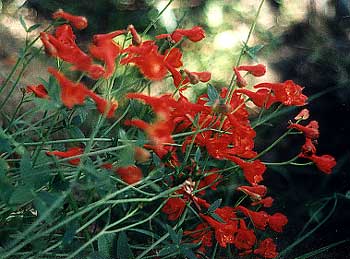
Dwarf Scarlet Larkspur; aka,
Canyon Delphinium
The red rose cries, 'She is near, she is near;'
And the white rose weeps, 'She is late;'
The larkspur listens, 'I hear, I hear;'
And the lily whispers, 'I wait.'
-"Maud"
by Alfred Lord Tennyson
(1809-1892)
by Alfred Lord Tennyson
(1809-1892)
Most people will associate Delphinium with blue flowers (as for example, Delphinium grandiflorum); but what a riot of brilliant red is D. nudicaule, Dwarf Scarlet Larkspur.
The selected cultivar 'Laurin' is particularly brightly colored. It is quite different from other delphiniums, with its horned or spurred tube-flowers "swimming" over the surface of the low foliage.
Its big cousin D. cardinale is also called Scarlet Larkspur, but it gets to be six feet tall, growing wild in Southern California. D. nudicaule is native to the Northern California & Southern Oregon's coastal mountain ranges. It is frequently spotted growing in dry rocky areas, or in open areas of woodlands.
It thrives in moist loamy soil in full sun or part shade. It does not always perennialize in the cooler environments a little further north into the Pacific Northwest, but if it does get established, after a couple years it will become very drought tolerant.
Rather like a hardy fuschia & other constant summer bloomers, it likes pretty regular fertilizing during the growing seasons. Ours was planted under the Apricot Surprise Deciduous Azalea, with fuschias, cape fuschias, & crane's-bills nearby.
Though cold-hardy, it is tender on Puget Sound & is best planted as a defacto annual to avoid disappointment. It will certainly flourish & bloom wonderfully for at least its first year. On Puget Sound, Dwarf Scarlet Larkspur blooms from June until first frost, then dies back; but this varies according to regional climates. In Yosemite National Forest it blooms March through June, & in really chilly places such as around the Great Lakes it has a shortened bloom season in June & July, & will most certainly have to be regarded as an annual rather than a perennial.
Ours tended to grow sideways away from the shade & into brightest area sun. In a more exposed location it would fall over in more directions, but ours leaned entirely one direction. The wirey stems are naturally too weak to hold the flowers upright. Planting it at the dripline of a woody shrub will help it do a little incidental "climbing" & bracing itself so it doesn't lay entirely sideways.
We were braced for the likelihood of it not perennializing in our climate, so were not too distraught when it did not return after its first winter. We got months of bright flowers out of it, & I enjoy trying marginal or tender perennials instead of outright annuals because I like to feel there's at least a chance of such a flower perennializing.